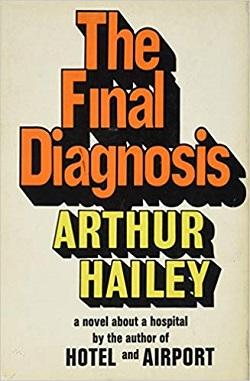Summary

The Final Diagnosis
by Arthur Hailey
A look at the workings of a modern day hospital through the lens of the pathologists department.
.
Read
The Final Diagnosis on http://kissnovel.net
Martial Peak Reviews
Arthur Hailey's The Final Diagnosis offers a gripping exploration of the inner workings of a hospital, focusing specifically on the pathologists' department. This novel, first published in 1959, remains a compelling read for those interested in the medical field and the intricate dynamics of hospital life. Hailey, known for his meticulous research and ability to weave complex narratives, delivers a story that is both informative and emotionally engaging.
At its core, The Final Diagnosis is a study of the human condition under the pressures of medical practice. The novel is set in a large hospital, where the pathologists' department plays a crucial role in diagnosing diseases and determining treatment plans. Hailey's portrayal of this department is both detailed and realistic, reflecting his commitment to authenticity. The novel delves into the challenges faced by medical professionals, including the high stakes of their decisions and the constant pressure to perform accurately and efficiently.
One of the most striking aspects of the book is its character development. Hailey introduces a diverse cast of characters, each with their own motivations, strengths, and weaknesses. The protagonist, Dr. Joe Pearson, is a seasoned pathologist whose old-school methods clash with the modern approaches advocated by younger doctors. Pearson is depicted as a complex character, embodying both the wisdom of experience and the stubbornness that often accompanies it. His journey throughout the novel is one of self-discovery and adaptation, as he grapples with the changing landscape of medical practice.
In contrast, Dr. David Coleman represents the new wave of medical professionals, eager to implement innovative techniques and challenge the status quo. Coleman's character is well-developed, showcasing the idealism and determination of youth. The tension between Pearson and Coleman serves as a central theme in the novel, highlighting the generational divide and the inevitable evolution of medical practices. Hailey expertly navigates this dynamic, creating a narrative that is both thought-provoking and emotionally resonant.
Hailey's attention to detail is evident in his depiction of the hospital environment. The novel provides a comprehensive look at the various departments and the intricate web of relationships that sustain the hospital's operations. From the administrative challenges to the ethical dilemmas faced by doctors, Hailey captures the complexity of hospital life with precision. His ability to convey the urgency and gravity of medical decisions adds a layer of tension to the narrative, keeping readers engaged from start to finish.
One of the novel's most compelling themes is the conflict between tradition and innovation. Hailey explores this theme through the lens of medical practice, illustrating the challenges faced by professionals as they navigate the ever-evolving landscape of healthcare. The novel raises important questions about the role of technology in medicine and the balance between human intuition and scientific advancement. Hailey's nuanced portrayal of this conflict encourages readers to reflect on the broader implications of progress and the importance of adaptability in a rapidly changing world.
Another significant theme is the human element of medicine. Hailey emphasizes the emotional and ethical dimensions of medical practice, highlighting the impact of doctors' decisions on patients' lives. The novel delves into the moral dilemmas faced by medical professionals, exploring the fine line between life and death and the weight of responsibility borne by those in the field. Hailey's portrayal of these challenges is both poignant and realistic, offering a sobering reminder of the human cost of medical practice.
In comparison to other medical dramas, such as Robin Cook's Coma or Michael Crichton's Five Patients, Hailey's The Final Diagnosis stands out for its focus on the pathologists' department and its exploration of the internal dynamics of a hospital. While Cook and Crichton often emphasize the suspense and thriller elements of medical narratives, Hailey opts for a more character-driven approach, delving into the personal and professional lives of his characters. This focus on character development and interpersonal relationships adds depth to the narrative, setting it apart from other works in the genre.
Overall, The Final Diagnosis is a compelling and insightful novel that offers a unique perspective on the medical field. Hailey's meticulous research and attention to detail create a vivid and realistic portrayal of hospital life, while his exploration of themes such as tradition versus innovation and the human element of medicine adds depth and complexity to the narrative. The novel's well-developed characters and engaging storyline make it a must-read for anyone interested in the intricacies of medical practice and the challenges faced by those in the field.
In conclusion, Arthur Hailey's The Final Diagnosis is a masterful exploration of the medical world, offering a nuanced and thought-provoking look at the challenges and triumphs of hospital life. Its enduring relevance and compelling narrative make it a standout work in the genre, appealing to both medical professionals and general readers alike. Whether you are drawn to the intricacies of medical practice or the human stories that unfold within a hospital's walls, this novel is sure to leave a lasting impression.
























Reviews 0
Post a Reviews: